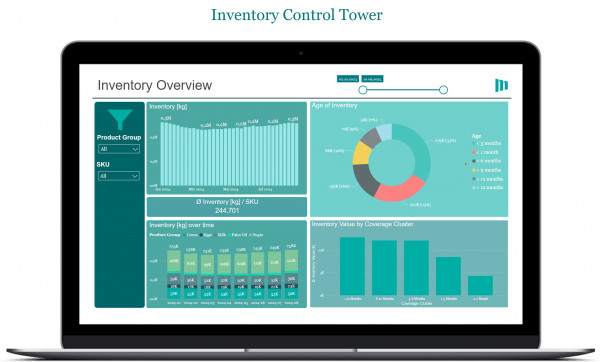

Optimizing Supply Chain Processes and Organizations with a Control Tower
The Challenge
Breaking Down the Black Box of Inventory Management
Many organizations struggle with understanding the full scope of their inventory performance. Complex supply chains, fragmented systems, and unpredictable market conditions often result in inefficiencies, such as overstocking or understocking. These challenges lead to financial strain, operational disruptions, and a lack of trust between stakeholders.
The need for a solution that brings visibility, simplifies complexity, and drives actionable insights is more important than ever. This is where an Inventory Control Tower comes into play.

The Approach
Leveraging the Power of an Inventory Control Tower
An Inventory Control Tower enables organizations to analyze, structure, and act on their inventory data efficiently. The project approach to implementing such a solution can be broken down into the following core pillars:
1. Understand & Structure Data
At the heart of effective inventory management lies robust data analysis. The first step involves consolidating disparate data sources, such as ERP systems, demand forecasts, and supplier information, into a unified structure. This allows for clear visibility into inventory levels, product categories, and key performance metrics.
Key Activities:
2. Seamless ERP Integration
To avoid disruptions and ensure sustainable operations, the integration of the Inventory Control Tower with existing ERP systems is critical. This enables real-time data flow and ensures consistency across departments.
Key Benefits:
3. Profit from Inventory Transparency
The Inventory Control Tower provides actionable insights by visualizing key metrics such as age of inventory, stock coverage, and inventory turnover. This allows organizations to pinpoint inefficiencies and implement targeted improvements, such as adjusting order volumes or streamlining supply chain processes.
Expected Outcomes:
Results
Driving Sustainable Change in Inventory Management
By following this structured approach, organizations can transform inventory management into a strategic capability. An Inventory Control Tower not only addresses immediate inefficiencies but also lays the foundation for continuous improvement. Companies benefit from reduced operational costs, improved service levels, and greater resilience in the face of market volatility.
With a clear focus on data, integration, and transparency, inventory management no longer needs to be a black box. Instead, it becomes a source of competitive advantage, empowering organizations to achieve sustainable growth.
Stay tuned for our next case study article about Strategic Inventory Placement.
If you have any questions or would like to get more information about the topic, please do not hesitate to contact us.
Contact
